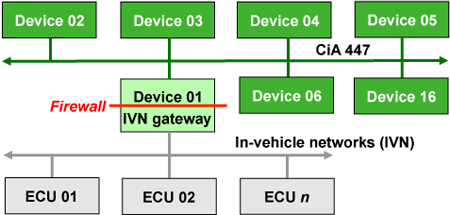CiA® 447 series: CANopen application profile for special-purpose car add-on devices

This profile standardizes the electronic interfaces of the add-on equipment for special-purpose passenger cars such as taxis, police cars, emergency vehicles, vehicles for handicapped persons etc. Use of CiA 447 allows the car manufacturer to choose appropriate add-on devices (e.g. taximeter, roof bar, camera) from diverse suppliers. Standardized interfaces simplify the integration of the add-on devices based on the plug-and-play principle. Development effort, time and costs are minimized. The effort for testing and for authorization of special add-on devices is reduced. Vehicle manufacturers do not require additional agreements with device suppliers.
The device suppliers benefit from the possibility to sell the same devices to diverse car manufacturers. The devices do not have to be adapted to a particular manufacturer or to a type of vehicle. Diagnostics of the special equipment may be done via off-the-shelf CANopen tools.
The four-part application profile specifies the CAN physical layer, application, configuration and diagnostic parameters transmitted within a car add-on device network. Add-on devices communicate with the car’s IVN (in-vehicle network) gateway, which provides IVN-signals in a predefined manner and serves as an NMT (network management) manager in the add-on network.

Part 1 defines the physical layer (e.g. connectors), the general system architecture, the boot-up procedure, and some common communication parameter objects. For node-ID assignment it is recommended to use LSS (layer setting services) Fastscan procedure as defined in CiA 305. Further, services and protocols for power management (sleep and wake-up mechanisms) as well as timely relationships of the CiA 447 protocols are specified. Part 2 gives an overview about the defined virtual devices (indivisible functionality of a device e.g. IVN gateway, taximeter, printer) and the corresponding configuration and process parameters. The detailed process data and configuration parameter definitions are provided in part 3.
Part 4 specifies predefined CAN-IDs (CAN identifier) for SDOs and PDOs as well as the content of the process data objects (PDOs). As the number of devices in the car add-on network is limited to 16, a full meshed SDO communication (each device communicates with all other devices via SDO) is possible. Further CAN-IDs are specified for use of extended diagnostic functions according to ISO 14229-1 (UDS) and ISO 14229-3 (ISO-TP).
The related SIG (special interest group) is currently working on the CiA 312-5 document, which defines the test specification for the CiA 447 devices. It is also intended to submit the CiA 447 profile for the international standardization.
| Title | Details | Published Size |
Status Action |
|---|---|---|---|
|
|
ScopeThis specification specifies the CANopen application layer. This includes the data types, encoding rules and object dictionary objects as well as the CANopen communication services and protocols. In addition, this specification specifies the CANopen network management services and protocols. This specification specifies the CANopen communication profile, e.g. the physical layer, the pre- defined communication object identifier connection set, and the content of the Emergency, Time- stamp, and Sync communication objects. |
2011-02-21 3 MB | PAS Login |
|
|
ScopeThis document specifies the layer setting services (LSS) and protocols for CANopen. These services and protocols are used to inquire or to change the settings of three parameters of the physical layer, data link layer, and application layer on a CANopen device with LSS slave capability by a CANopen device with LSS master capability via the CAN network. The following parameters may be inquired or changed: • Node-ID of the CANopen device; • Bit timing parameters of the physical layer (bit rate); • LSS address compliant to the identity object (1018h) |
2013-05-08 2 MB | DSP Login |
|
|
Scope |
2016-06-06 2 MB | WD Login |
|
|
ScopeThis CANopen application profile specifies the CAN physical layer as well as application, configuration and diagnostic parameters for the add -on devices used in special-purpose passenger cars such as taximeter, roof bar, etc. The specification comprises the following parts: • Part 1: General definitions; • Part 2: Virtual device definition; • Part 3: Detailed process data specification; • Part 4: Pre-defined CAN-IDs and communication objects. This part defines the physical layer, the general system architecture, and some common communication parameter objects. |
2015-12-14 1 MB | DSP Login |
|
|
ScopeThis CANopen application profile specifies the physical layer as well as application, configuration and diagnostic parameters for the add -on devices used in special-purpose passenger cars such as taximeter, roof bar, etc. The specification comprises the following parts: • Part 1: General definitions; • Part 2: Virtual device definition; • Part 3: Detailed process data specification; • Part 4: Pre-defined CAN-IDs and communication objects. This part defines the virtual devices. It also defines, which process data and parameters are used by the virtual devices. |
2018-09-07 431 KB | DSP Login |
|
|
ScopeThis CANopen application profile specifies the physical layer as well as application, configuration and diagnostic parameters for the add -on devices used in special-purpose passenger cars such as taximeter, roof bar, etc. The specification comprises the following parts: • Part 1: General definitions; • Part 2: Virtual device definition; • Part 3: Detailed process data specification; • Part 4: Pre-defined CAN-IDs and communication objects. This part specifies in detail the process data and parameters of the virtual devices. |
2018-09-07 4 MB | DSP Login |
|
|
ScopeThis CANopen application profile specifies the CAN physical layer as well as application, configuration and diagnostic parameters for the add -on devices used in special-purpose passenger cars such as taximeter, roof bar, etc. The specification comprises the following parts: • Part 1: General definitions; • Part 2: Virtual device definition; • Part 3: Detailed process data specification; • Part 4: Pre-defined CAN-IDs and communication objects. This part specifies the pre-defined CAN-IDs and communication objects. |
2015-12-14 490 KB | DSP Login |
|
|
ScopeThis document specifies the application profile specific tests for CiA 447 devices. The tests include: Electronic data sheet-based verification of object dictionary entries; Application profile specific tests for power management, Layer Settings Services and Network Management States; Dynamic tests covering message timings and stress tests; Integration tests based on post analysis of trace recordings; Virtual device specific function tests. The document also references the test cases specified in the CiA 310 CANopen conformance test plan. |
2017-01-13 2 MB | DSP Login |
|
|
ScopeThis CANopen application profile specifies the physical layer as well as application, configuration and diagnostic parameters for the add-on devices used in special-purpose passenger cars such as taximeter, roof bar, etc. The specification comprises the following parts: • Part 1: General definitions • Part 2: Virtual device definition • Part 3: Detailed process data specification • Part 4: Pre-defined CAN-IDs and communication objects This part specifies in detail the process data and parameters of the virtual devices. |
2024-09-03 4 MB | WD Login |